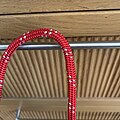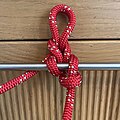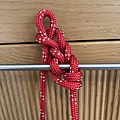| Tumble hitch | |
|---|---|
 Very clean release and very little distortion of the main load bearing | |
| Names | Tumble hitch, a better Highwayman's hitch, Bank Robbers Knot, Getaway hitch, Quick-release knot |
| Category | Hitch |
| Related | Highwayman's hitch, Mooring hitch |
| Releasing | Non-jamming |
| Typical use | Quick-release, draw loop hitch |
| Caveat | potentially unstable |
The tumble hitch is a "slip-free", quick-release hitch knot used for temporarily securing a rope such that it can be released easily to be completely free of the hitched-to object (instead of parts still being wrapped around it). The hitch might be able to be released with a tug of the working end, even when under tension; but the workings depend upon materials and forces; note that in some cases, "under tension" will amount to simply being tied and the line itself giving significant tension by weight. The tumble hitch is tied in the bight.
Contents
Usually two locking turns (as in the picture here) suffice for a knot secure enough for most purposes, but another could be added for further stability. The general knotting principles evident in this and the well-published "highwayman's hitch" can be implemented in a variety of ways. This knot was designed specifically to avoid the problem of the highwayman's hitch of putting the full force of loading upon the locking toggle ("slip") bight, which esp. in soft cordage can collapse that and pull it through the bight "frame" it had locked against! Hence, The Notable Knot Index recommends the tumble hitch as a more stable hitch than the highwayman's hitch. [1]



